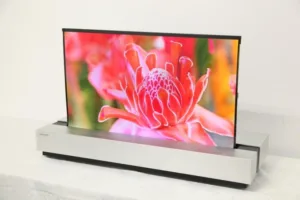Developed 30V type 4K flexible organic EL display World’s largest1, color filter-less organic EL display using a 30-inch diagonal film substrate, to realize a “rollable” product that can be stored neatly. The newly developed product is an organic EL display in which an element that emits light in each of RGB (red, green, and blue) colors (RGB light emission method) is formed on a flexible 30-inch diagonal film substrate. (Note – translated from Japanese release)
It is the world’s largest by composition. By forming elements that emit light in each color with high accuracy by vapor deposition, a color filter is unnecessary and high light utilization efficiency is achieved. In addition, by using a film substrate, a panel display with a thickness of about 0.5mm can be rolled up compactly (with a radius of about 2cm) and stored neatly in the lower housing.
IGZO2 is used as a thin film transistor to drive organic EL elements. NHK’s original signal processing and panel drive technology are used to improve screen brightness uniformity and video clarity.
In June 2018, we began mass production of Japan’s first flexible organic EL display for smartphones. Going forward, we will continue to develop more advanced technologies and open up the future of displays.
The new product is NHK / JEITA (Japan Electronics and Information Technology Industries Association) from International Broadcast Equipment Exhibition “Inter BEE 2019” to be held at Makuhari Messe (Mihama-ku, Chiba) from November 13 (Wednesday) to 15 (Friday) ) We will exhibit at the booth.
Main features:
- The world’s largest color filterless (RGB light emission) high-definition 4K flexible organic EL display using a 30-inch diagonal film substrate
- Color filterless panel structure achieves high light utilization efficiency
- Due to the flexibility of the film substrate, the display can be stored compactly (winding radius: approx. 2cm)
- NHK’s unique signal processing and panel drive technology improve brightness uniformity and video clarity
1 As a display equipped with an organic EL element that emits light (RGB light emission) to each color of RGB (red, green, blue) without using a color filter on a film substrate (as of November 8, 2019. Sharp research) ).
2 An oxide semiconductor composed of In (indium), Ga (gallium), Zn (zinc), and O (oxygen). Used as a TFT (thin film transistor) semiconductor material for driving organic EL and liquid crystal displays.
Main Specifications
|
Screen size |
Diagonal 30 inches (approximately 76cm) |
|
aspect ratio |
16: 9 |
|
Number of pixels |
3840 pixels wide × 2160 pixels high (4K) |
|
frame rate |
60 frames / second |
|
Organic EL device structure / formation method |
Top emission type3 / RGB painting4 |
|
Driving transistor |
IGZO-TFT |
3 A highly efficient light utilization method that extracts light emitted from organic EL elements in a direction not blocked by thin film transistors (TFTs).
4 RGB (red, green, blue) materials that emit light of each color are arranged on the substrate by vapor deposition (painted separately) to form one pixel (Side by Side method). On the other hand, there is a method of performing RGB display using an organic EL element that emits white light and a color filter.

